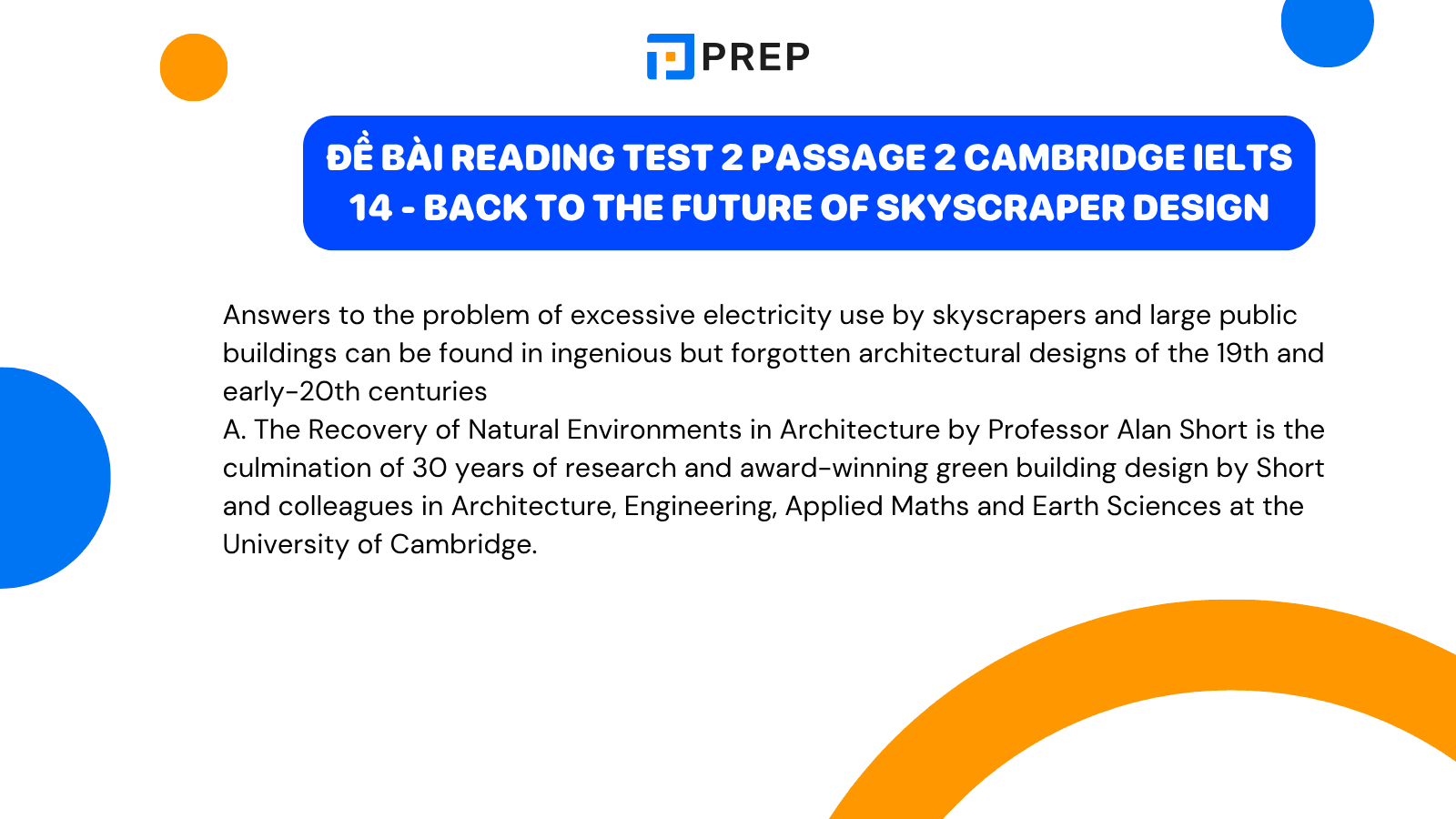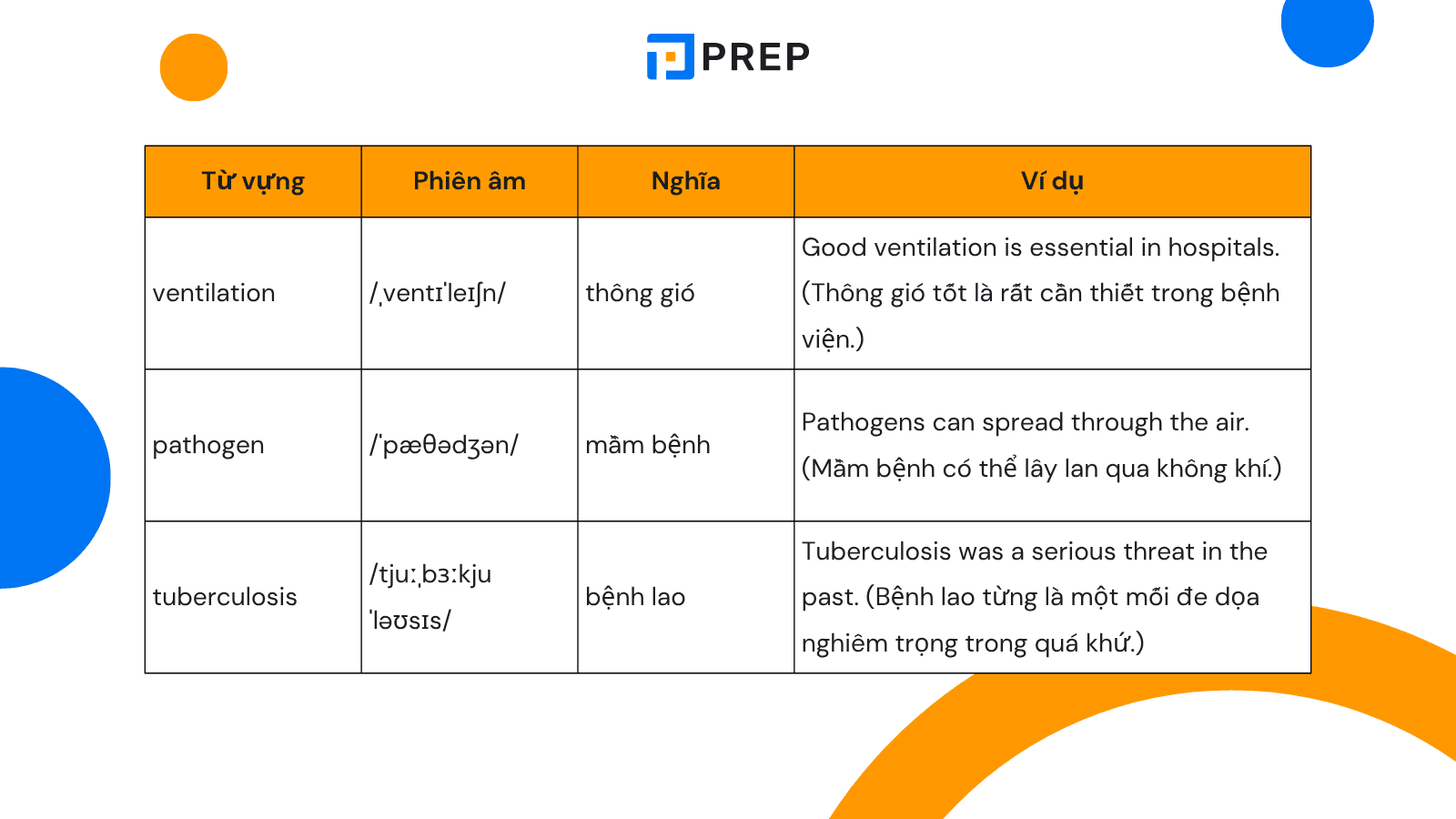Đề bài và đáp án bài Reading Test 2 passage 2 Cambridge IELTS 14 - Back to the future of skyscraper design
Bài đọc “Back to the future of skyscraper design” trong Cambridge IELTS 14 Test 2 Passage 2 tập trung vào chủ đề sự phát triển và cải tiến trong thiết kế nhà chọc trời, đặc biệt nhấn mạnh đến xu hướng quay lại với những giải pháp bền vững, tiết kiệm năng lượng và thân thiện với môi trường. Thông qua bài đọc, thí sinh không chỉ tìm hiểu về các đặc điểm kỹ thuật và kiến trúc hiện đại mà còn rèn luyện kỹ năng nắm bắt ý chính, xác định chi tiết quan trọng và suy luận từ thông tin. Bài viết dưới đây, Prep tổng hợp đề bài đầy đủ, đáp án chính xác và phần giải thích chi tiết cho từng câu hỏi, giúp bạn hiểu rõ hơn cách tư duy khi làm dạng bài đọc học thuật trong IELTS.

I. Đề bài Reading Test 2 passage 2 Cambridge IELTS 14 - Back to the future of skyscraper design
Reading Back to the future of skyscraper design
Back to the future of skyscraper design
Answers to the problem of excessive electricity use by skyscrapers and large public buildings can be found in ingenious but forgotten architectural designs of the 19th and early-20th centuries
A. The Recovery of Natural Environments in Architecture by Professor Alan Short is the culmination of 30 years of research and award-winning green building design by Short and colleagues in Architecture, Engineering, Applied Maths and Earth Sciences at the University of Cambridge.
‘The crisis in building design is already here,’ said Short. ‘Policy makers think you can solve energy and building problems with gadgets. You can’t. As global temperatures continue to rise, we are going to continue to squander more and more energy on keeping our buildings mechanically cool until we have run out of capacity.’
B. Short is calling for a sweeping reinvention of how skyscrapers and major public buildings are designed – to end the reliance on sealed buildings which exist solely via the ‘life support’ system of vast air conditioning units.
Instead, he shows it is entirely possible to accommodate natural ventilation and cooling in large buildings by looking into the past, before the widespread introduction of air conditioning systems, which were ‘relentlessly and aggressively marketed’ by their inventors.
C. Short points out that to make most contemporary buildings habitable, they have to be sealed and air conditioned. The energy use and carbon emissions this generates is spectacular and largely unnecessary. Buildings in the West account for 40–50% of electricity usage, generating substantial carbon emissions, and the rest of the world is catching up at a frightening rate. Short regards glass, steel and air-conditioned skyscrapers as symbols of status, rather than practical ways of meeting our requirements.
D. Short’s book highlights a developing and sophisticated art and science of ventilating buildings through the 19th and earlier-20th centuries, including the design of ingeniously ventilated hospitals. Of particular interest were those built to the designs of John Shaw Billings, including the first Johns Hopkins Hospital in the US city of Baltimore (1873–1889).
‘We spent three years digitally modelling Billings’ final designs,’ says Short. ‘We put pathogens* in the airstreams, modelled for someone with tuberculosis (TB) coughing in the wards and we found the ventilation systems in the room would have kept other patients safe from harm.
E. 'We discovered that 19th-century hospital wards could generate up to 24 air changes an hour – that's similar to the performance of a modern-day, computer-controlled operating theatre. We believe you could build wards based on these principles now. Single rooms are not appropriate for all patients. Communal wards appropriate for certain patients – older people with dementia, for example – would work just as well in today’s hospitals, at a fraction of the energy cost.’ Professor Short contends the mindset and skill-sets behind these designs have been completely lost, lamenting the disappearance of expertly designed theatres, opera houses, and other buildings where up to half the volume of the building was given over to ensuring everyone got fresh air.
F. Much of the ingenuity present in 19th-century hospital and building design was driven by a panicked public clamouring for buildings that could protect against what was thought to be the lethal threat of miasmas – toxic air that spread disease. Miasmas were feared as the principal agents of disease and epidemics for centuries, and were used to explain the spread of infection from the Middle Ages right through to the cholera outbreaks in London and Paris during the 1850s. Foul air, rather than germs, was believed to be the main driver of 'hospital fever', leading to disease and frequent death. The prosperous steered clear of hospitals.
While miasma theory has been long since disproved, Short has for the last 30 years advocated a return to some of the building design principles produced in its wake.
G. Today, huge amounts of a building's space and construction cost are given over to air conditioning. 'But I have designed and built a series of buildings over the past three decades which have tried to reinvent some of these ideas and then measure what happens.
'To go forward into our new low-energy, low-carbon future, we would be well advised to look back at design before our high-energy, high-carbon present appeared. What is surprising is what a rich legacy we have abandoned.’
H. Successful examples of Short’s approach include the Queen’s Building at De Montfort University in Leicester. Containing as many as 2,000 staff and students, the entire building is naturally ventilated, passively cooled and naturally lit, including the two largest auditoria, each seating more than 150 people. The award-winning building uses a fraction of the electricity of comparable buildings in the UK. Short contends that glass skyscrapers in London and around the world will become a liability over the next 20 or 30 years if climate modelling predictions and energy price rises come to pass as expected.
I. He is convinced that sufficiently cooled skyscrapers using the natural environment can be produced in almost any climate. He and his team have worked on hybrid buildings in the harsh climates of Beijing and Chicago – built with natural ventilation assisted by back-up air conditioning – which, surprisingly perhaps, can be switched off more than half the time on milder days and during the spring and autumn.
Short looks at how we might reimagine the cities, offices and homes of the future. Maybe it's time we changed our outlook.
Questions 14-18
Reading Passage 2 has nine sections, A-I.
Which section contains the following information?
Write the correct letter, A-I, in boxes 14-18 on your answer sheet.
-
why some people avoided hospitals in the 19th century ........................
-
a suggestion that the popularity of tall buildings is linked to prestige ........................
-
a comparison between the circulation of air in a 19th-century building and modern standards ........................
-
how Short tested the circulation of air in a 19th-century building ........................
-
an implication that advertising led to the large increase in the use of air conditioning ........................
Questions 19-26
Complete the summary below.
Choose ONE WORD ONLY from the passage for each answer.
Write your answers in boxes 19-26 on your answer sheet.
Ventilation in 19th-century hospital wards
Professor Alan Short examined the work of John Shaw Billings, who influenced the architectural 19 ______________________ of hospitals to ensure they had good ventilation. He calculated that 20 ______________________ in the air coming from patients suffering from 21 ______________________ would not have harmed other patients. He also found that the air in 22 ______________________ in hospitals could change as often as in a modern operating theatre. He suggests that energy use could be reduced by locating more patients in 23 ______________________ areas.
A major reason for improving ventilation in 19th-century hospitals was the demand from the 24 ______________________ for protection against bad air, known as 25 ______________________. These were blamed for the spread of disease for hundreds of years, including epidemics of 26 ______________________ in London and Paris in the middle of the 19th century.

II. Đáp án
Tham khảo đáp án bài đọc Reading Passage 2, Questions 14-26
-
F
-
C
-
E
-
D
-
B
-
design(s)
-
pathogens
-
tuberculosis
-
wards
-
communal
-
public
-
miasmas
-
cholera
III. Giải thích đáp án chi tiết bài đọc IELTS Cambridge 14 Back to the future of skyscraper design
Questions 14–18
14. F
→ Đoạn F: “Foul air, rather than germs, was believed … The prosperous steered clear of hospitals.”
→ Người giàu tránh bệnh viện vì sợ khí độc (miasmas).
15. C
→ Đoạn C: “Short regards glass, steel and air-conditioned skyscrapers as symbols of status, rather than practical ways…”
→ Các tòa nhà cao tầng được xem như biểu tượng địa vị, không phải vì tính thực tế.
16. E
→ Đoạn E: “19th-century hospital wards could generate up to 24 air changes an hour – similar to … operating theatre.”
→ So sánh trực tiếp giữa bệnh viện thế kỷ 19 và phòng mổ hiện đại.
17. D
→ Đoạn D: “We put pathogens in the airstreams … someone with tuberculosis coughing … the systems kept other patients safe.”
→ Short thử nghiệm bằng cách mô phỏng vi khuẩn trong luồng khí.
18. B
→ Đoạn B: “… before the widespread introduction of air conditioning systems, which were relentlessly and aggressively marketed by their inventors.”
→ Việc quảng cáo rầm rộ đã khiến điều hòa lan rộng.
Questions 19–26
19. design(s) – Đoạn D: nhắc tới “the design of ingeniously ventilated hospitals by John Shaw Billings”.
20. pathogens – Đoạn D: “We put pathogens in the airstreams…”
21. tuberculosis – Đoạn D: “… modelled for someone with tuberculosis coughing…”
22. wards – Đoạn E: “19th-century hospital wards could generate up to 24 air changes an hour.”
23. communal – Đoạn E: “… Communal wards … would work just as well…”
24. public – Đoạn F: “Much of the ingenuity … was driven by a panicked public clamouring for buildings…”
25. miasmas – Đoạn F: “Miasmas were feared as the principal agents of disease…”
26. cholera – Đoạn F: “… cholera outbreaks in London and Paris during the 1850s.”
Xem thêm: Đề bài và đáp án Cambridge IELTS 14 Test 2 listening section 2 Visit to Branley Castle
IV. Từ vựng hay trong bài
|
Từ vựng |
Phiên âm |
Nghĩa |
Ví dụ |
|
ventilation |
/ˌventɪˈleɪʃn/ |
thông gió |
Good ventilation is essential in hospitals. (Thông gió tốt là rất cần thiết trong bệnh viện.) |
|
pathogen |
/ˈpæθədʒən/ |
mầm bệnh |
Pathogens can spread through the air. (Mầm bệnh có thể lây lan qua không khí.) |
|
tuberculosis |
/tjuːˌbɜːkjuˈləʊsɪs/ |
bệnh lao |
Tuberculosis was a serious threat in the past. (Bệnh lao từng là một mối đe dọa nghiêm trọng trong quá khứ.) |
|
ward |
/wɔːd/ |
buồng bệnh |
The nurse entered the ward to check the patients. (Y tá bước vào buồng bệnh để kiểm tra bệnh nhân.) |
|
communal |
/ˈkɒmjənl/ |
chung |
They lived in a communal house. (Họ sống trong một ngôi nhà chung.) |
|
miasma |
/miˈæzmə/ |
khí độc |
People once believed diseases were caused by miasmas. (Người ta từng tin rằng bệnh tật do khí độc gây ra.) |
|
cholera |
/ˈkɒlərə/ |
dịch tả |
Cholera outbreaks were deadly in the 19th century. (Các đợt bùng phát dịch tả rất chết người vào thế kỷ 19.) |
|
prestige |
/preˈstiːʒ/ |
uy tín, danh vọng |
Tall glass buildings are often built for prestige. (Những tòa nhà kính cao thường được xây để thể hiện uy tín.) |
|
sustainable |
/səˈsteɪnəbl/ |
bền vững |
Sustainable design helps reduce energy use. (Thiết kế bền vững giúp giảm tiêu thụ năng lượng.) |
|
legacy |
/ˈleɡəsi/ |
di sản |
The hospital is part of the city’s architectural legacy. (Bệnh viện là một phần trong di sản kiến trúc của thành phố.) |

Trên đây là đề bài và đáp án kèm giải thích chi tiết cho bài đọc Cambridge IELTS 14 Back to the future of skyscraper design. Hy vọng tài liệu trên sẽ giúp bạn ôn luyện IELTS hiệu quả hơn và đạt được band điểm như mong đợi.
Học tiếng Anh online dễ dàng hơn với PREP - Nền tảng Học & Luyện thi thông minh cùng AI. Nhờ công nghệ AI độc quyền, bạn có thể tự học trực tuyến ngay tại nhà, chinh phục lộ trình học IELTS, TOEIC, tiếng Anh giao tiếp hiệu quả. Bên cạnh đó, học viên còn có sự hỗ trợ tuyệt vời từ Teacher Bee AI, trợ lý ảo giúp bạn giải đáp thắc mắc và đồng hành 1-1 trong suốt quá trình học tập. Hãy click TẠI ĐÂY hoặc liên hệ HOTLINE 0931428899 để nhận tư vấn chi tiết về các khóa học tiếng Anh chất lượng nhất thị trường!
Tải ngay app PREP để bắt đầu hành trình học tiếng Anh tại nhà với chương trình học luyện thi online chất lượng cao.

Chào bạn! Mình là Hiền Hoàng, hiện đang đảm nhận vai trò quản trị nội dung sản phẩm tại Blog của website prepedu.com.
Với hơn 5 năm tự học các ngoại ngữ như tiếng Anh, tiếng Trung và ôn luyện một số kỳ thi IELTS, TOEIC, HSK, mình đã tự đúc rút được nhiều kinh nghiệm để hỗ trợ hàng nghìn người đang gặp khó khăn trong việc học ngoại ngữ. Hy vọng rằng những chia sẻ phía trên sẽ giúp ích cho bạn trong quá trình tự ôn luyện thi hiệu quả tại nhà!
Bình luận
Nội dung premium
Xem tất cảLộ trình cá nhân hoá
Có thể bạn quan tâm
Kết nối với Prep
MSDN: 0109817671.
Địa chỉ liên hệ: Tòa nhà Vinaconex, 34 Láng Hạ, phường Láng, TP Hà Nội.
Địa chỉ kinh doanh: Lô 21 C2 Khu đô thị Nam Trung Yên, phường Yên Hòa, TP Hà Nội.
Trụ sở: Số nhà 20, ngách 234/35 đường Hoàng Quốc Việt, phường Nghĩa Đô, TP Hà Nội.
Phòng luyện ảo - Trải nghiệm thực tế - Công nghệ hàng đầu.
Hotline: 0931 42 8899.
Trụ sở: Số nhà 20, ngách 234/35 đường Hoàng Quốc Việt, phường Nghĩa Đô, TP Hà Nội.
Giấy chứng nhận hoạt động đào tạo, bồi dưỡng số 1309/QĐ-SGDĐT ngày 31 tháng 07 năm 2023 do Sở Giáo dục và Đào tạo Hà Nội cấp.























